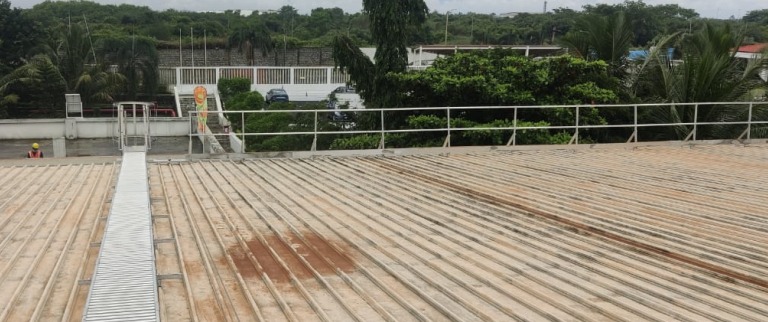June 19,2025
Why Every Rooftop Needs a Roof Guardrails & Barricade System (Before It’s Too Late!)

Table of Content:
- What is a rooftop guardrail system?
- What are the key features of modern roof safety railing systems?
- What are the advantages of Installing Roof Guardrails?
- What are the applications of rooftop guardrails?
- How to select the right rooftop fall protection system in India?
- What should be included in a roof guardrails maintenance checklist?
Working at heights remains one of the most hazardous tasks in construction, maintenance, and industrial work. In India, where rooftop access is common across commercial, residential, and industrial buildings, falls continue to be a leading cause of workplace injuries. That’s why having a rooftop guardrail system in India isn’t just a recommendation—it’s a necessity.
Don’t wait for a life-altering accident. Investing in a robust roof edge protection handrail for commercial buildings or residential complexes offers critical safety without compromising access or roof integrity.
This guide will walk you through the benefits, features, applications, and how to select the right system—from a freestanding rooftop fall protection system to a non-penetrating guardrail solution for sensitive rooftops.
What Is a Rooftop Guardrail System?
A rooftop guardrail system is a barrier installed along the edges of rooftops to prevent accidental falls. These systems, including modular roof safety railing system installations, provide passive fall protection for workers and service teams during rooftop inspections or maintenance.
Commonly used in:
- High-rise offices
- Warehouses
- Factories
- Residential buildings with accessible terraces
In India, these systems are gaining traction due to increasing compliance requirements and growing awareness of rooftop safety.
Key Features of Today’s Roof Safety Systems
Modern roof safety railing systems come with multiple features that ensure safety, durability, and ease of use:
- Non-Penetrating Design :Many systems, such as freestanding units, are non-penetrating guardrail systems for rooftops, which means no drilling or damage to the roof membrane—crucial for waterproofed or insulated surfaces.
- Modular Construction: Quick and easy modular roof safety railing system installation allows flexibility across various roof types—whether flat, pitched, or oddly shaped.
- High-Quality Materials: Look for galvanized steel rooftop barricade systems. These offer corrosion resistance and weather durability, making them ideal for long-term use in industrial zones and coastal regions.
- Compliance with International Standards: An OSHA-compliant rooftop barricade system ensures your business meets global safety standards and avoids penalties during audits or inspections.
Advantages of Installing Roof Guardrails
- Improved Worker Safety: These systems act as a continuous passive safety measure.
- No Roof Damage: Thanks to freestanding rooftop fall protection systems, there’s no structural compromise.
- Cost-Efficiency: Reduces accidents, legal liabilities, and insurance claims.
- Fast Setup: Most systems are modular and can be installed without specialized labor.
- Versatility: Whether it’s for industrial rooftop safety railing solutions or home terraces, there’s a product fit for every need.
Common Applications Across Sectors
- Industrial Facilities: Frequent access to rooftop HVAC, solar panels, or storage systems makes these locations perfect for industrial rooftop safety railing solutions.
- Commercial Buildings: Roof edge protection handrails for commercial buildings are widely used in offices, malls, and airports for both safety and compliance.
- Construction Projects: Temporary freestanding rooftop fall protection systems ensure worker safety during active projects.
- Residential Complexes: Yes, even homes and apartments with open terraces can benefit from residential rooftop fall prevention railings, especially where children or elderly residents are present.
Choosing the Right Roof Guardrail System
When selecting a rooftop guardrail system, consider:
- Roof Type & Slope: Some roofs work better with modular systems, while others need customized support.
- Installation Needs: If roof integrity is a concern, opt for non-penetrating guardrail systems.
- Compliance & Safety: Always confirm if it’s an OSHA-compliant rooftop barricade system.
- Material Durability: Go for galvanized steel barricade systems for better weather resistance.
- Visual Impact: Choose a design that complements your building’s exterior.
Maintenance & Longevity
Like any other safety system, your guardrails need routine checks. A roof guardrails maintenance checklist (India-specific) should include:
- Checking for corrosion, especially on steel components.
- Ensuring joints and baseplates remain secure.
- Cleaning and inspecting for cracks, especially after storms or high winds.
- Recoating or replacing any weather-worn parts.
Regular maintenance ensures the system continues to perform at its best—saving lives and reducing costs.
Final Thoughts:
Whether you're managing a high-rise in Mumbai or overseeing an industrial plant in Pune, installing a rooftop guardrail system in India is no longer optional—it’s a safety standard. The right system—be it non-penetrating, modular, galvanized, or OSHA-compliant—will protect workers, meet regulations, and enhance the value of your infrastructure.
Make safety a permanent fixture on your rooftop. Choose smart. Choose secure. Choose Mtandt.